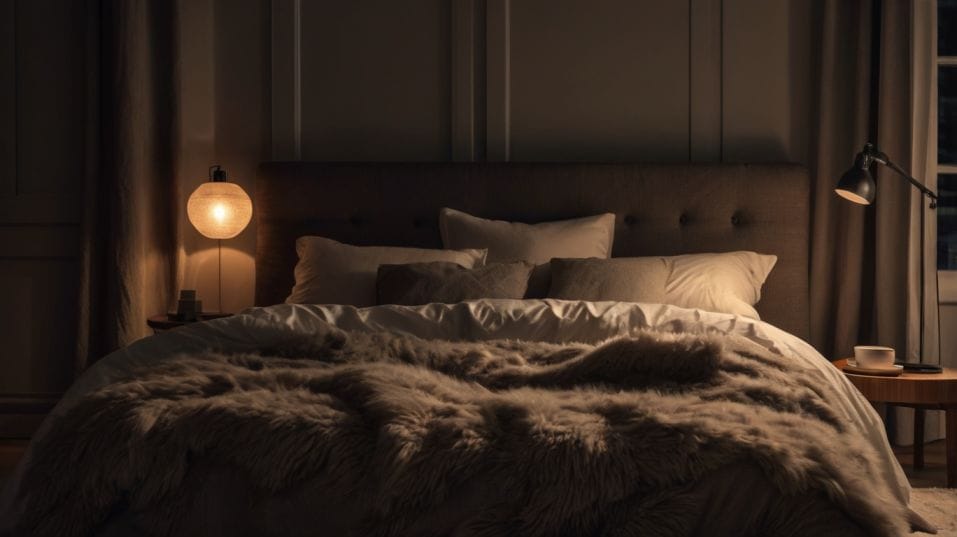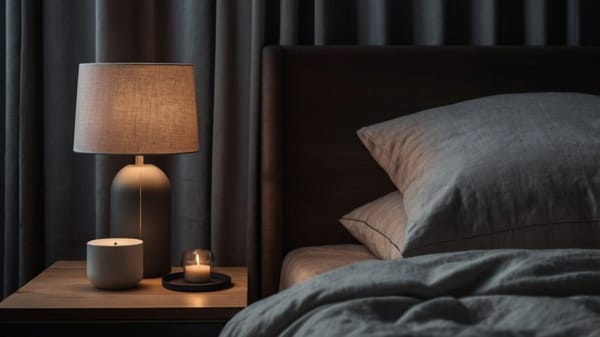Why Your Brain Won’t Turn Off at Bedtime
Struggling to turn off your brain at night? Learn simple, science-backed habits that help you fall asleep faster and wake up energized.

Why does your brain hit overdrive the moment you hit the pillow? If falling asleep feels like fighting a tidal wave of random thoughts, you're not broken—and you’re definitely not alone.
Modern life hijacks your brain's natural rhythms, leaving you stuck in overdrive when you should be winding down. The good news?
You can retrain your brain to power down naturally, unlocking better energy, sharper focus, and stronger recovery with just a few simple shifts.
The Hidden Battle in Your Brain
Your brain is a machine built for rhythm.
It’s wired to cycle between alertness and sleep based on two internal systems: the circadian rhythm (your natural 24-hour clock) and sleep pressure (the buildup of chemicals like adenosine that drive your need for rest).
When those systems fall out of sync—which happens way faster than you’d think—your brain keeps pushing when it should be powering down.
Stress overload, constant notifications, artificial light, caffeine at the wrong time, even inconsistent meal timing—every one of these sends mixed signals. Your brain stays in a defensive, ready-for-action mode long after your day should be over.
Biologically, you’re stuck in sympathetic dominance—your “fight or flight” nervous system running the show. Without deliberate effort to hit the brakes, your brain stays wired for survival, not restoration.
This isn't about "being bad at sleeping." It’s about creating conditions where sleep becomes the obvious next step, not a frustrating battle.

How to Train Your Brain to Power Down (and Actually Stay Down)
Rewiring your brain for better sleep isn’t about doing one big thing — it’s about stacking a few small, powerful habits that create the right environment for rest.
Each step you take sends a clear signal that it’s safe to slow down. Let's start with one of the most important foundations: rhythm.
Build your anchor points.
Sleep thrives on rhythm. If your wake-up and bedtime bounce around like a bad Wi-Fi signal, your circadian clock can’t lock into a pattern.
Start by setting consistent wake-up times—even if your bedtime still fluctuates for a while. It’s easier to anchor the morning first, and the evenings will follow naturally.
When your brain knows exactly when to expect sleep, it stops trying to micromanage everything at night.
Own your light exposure.
Your brain runs on light cues. Morning sunlight is the single most powerful way to lock your circadian clock into a healthy rhythm.
Ten minutes outside right after waking—even on cloudy days—gives your brain a clear “it’s daytime” signal that sets up better sleep 12–16 hours later.
At night, the opposite is true. Bright overhead lights, glowing phone screens, and TV marathons all scream "stay awake" to your brain.
About an hour before bed, dim the lights. Switch to lamps or even candlelight. Use screen dimmers like f.lux or your device’s Night Shift mode if you must use screens late.
Train with movement.
Your body needs physical stress to build sleep pressure. Sitting all day at a desk or couch doesn’t cut it. Exercise spikes adenosine levels, making you more biologically hungry for sleep.
You don’t need to start marathon training. Even short bursts of movement—a brisk walk, some pushups, a few sets of squats—can shift your system toward deeper rest.
Morning or afternoon workouts usually work best. Late-night sessions? They can backfire by flooding you with adrenaline right when you need to power down.
Design a proper wind-down sequence.
Your brain can't slam from "high alert" to "deep rest" like flipping a switch. It needs a gradual descent.
A good wind-down routine isn’t complicated. Think of it as a landing strip:
- Drop stimulation. Turn off intense shows, dramatic conversations, and mental heavy lifting.
- Shift to sensory. Stretching, deep breathing, a warm shower, reading an easy novel—things that pull you out of your head and into your body.
- Stick to the same flow every night. Repeating the same few steps trains your brain to recognize the pattern and start shutting down automatically.
Dump the noise in your head.
If your thoughts start racing the second you slow down, you’re not alone. Your brain often hoards unresolved tasks, feelings, and worries until there’s finally no distraction left to hide behind.
Solution? Give those thoughts a place to land before you lie down.
Do a quick brain dump: Write down everything swirling around—unfinished tasks, random worries, grocery lists, ideas for that side project.
You’re not solving anything right now—you’re just clearing mental real estate so your brain stops panicking about what it might forget.
Make your bedroom a brain-friendly zone.
Your bedroom should scream "sleep," not "battle station." Create an environment that nudges your system toward calm:
- Darkness: Invest in blackout curtains or a sleep mask.
- Cool temperatures: Ideal sleep happens around 65–68°F (18–20°C).
- Quiet: Use earplugs, white noise, or a fan if needed.
- Minimal clutter: A chaotic room = a chaotic mind. Keep it simple.
Bonus tip: Reserve your bed for sleep (and sex). No work emails, no scrolling marathons, no Netflix binges. Let your brain associate your bed with one thing only—rest.
Why This Matters (Beyond Just Feeling Rested)
Better sleep doesn’t just mean fewer groggy mornings. Locking in smarter sleep habits transforms how you show up in your life:
- Sharper focus so you stop wasting hours feeling half-awake
- Faster recovery after workouts, illness, or stress
- More consistent energy that doesn’t crash after lunch
- Better mood without forcing it
- Stronger resilience when real life inevitably throws curveballs
You’re not just "fixing sleep." You’re upgrading your entire system.
Final Thoughts
If your brain won’t shut off at night, it’s because you’re still running daytime programs at midnight. The fix isn’t forcing sleep harder—it’s setting up the right signals and rhythms so sleep becomes the natural next move.
Build a consistent schedule. Move your body. Get natural light. Own your wind-down. Create a sleep-friendly environment. Offload the chaos before your head hits the pillow.
You don’t need a total life overhaul. Just start. Tonight. Small wins stack fast when you know how to work with your brain, not against it. Reclaim your nights. Supercharge your days. Start now.




